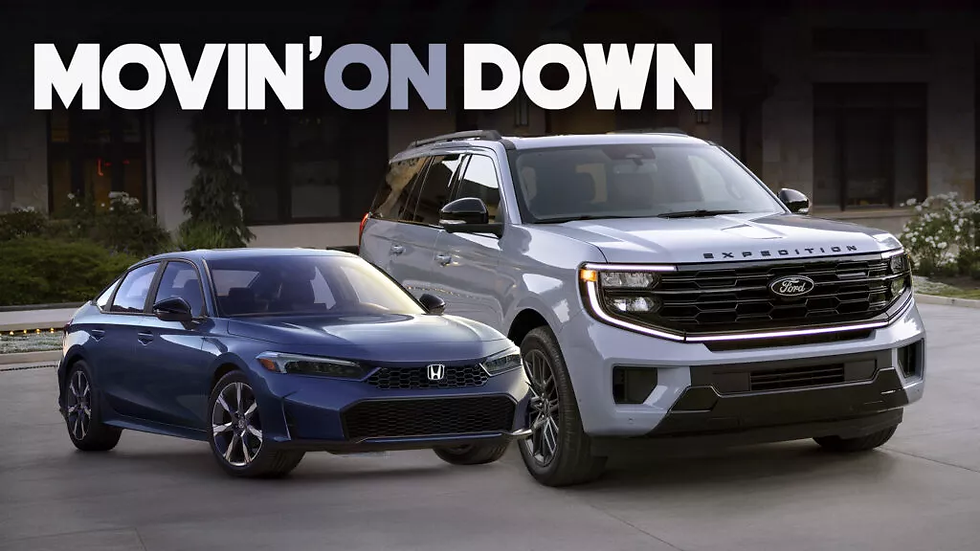Insight of the Day: High Prices Push Americans To Smaller Cars After Years Of Bigger Is Better
- InsightTrendsWorld

- Jan 13
- 4 min read
Overview:The article discusses a noticeable shift in the American automotive market, where rising costs—such as high interest rates, increasing fuel prices, and overall higher vehicle prices—are encouraging buyers to opt for smaller and more economical cars after years of favoring larger vehicles.
Detailed Findings:
Market Shift:
Sales of entry-level models increased by 23%.
Compact car sales climbed by 16% in November 2024.
Sub-compact SUV sales grew by 11.5% in the same period.
Sales of larger vehicles like pickup trucks and midsize SUVs have declined (1.9% and 2.3% respectively in 2024).
Price Pressures:
The average new car selling price reached an all-time high of $47,000.
Rising expenses (interest rates, fuel costs) are pushing buyers toward more affordable, compact options.
Supply Trends:
The number of affordable models (under $25,000) has decreased from over 45 in 2025 to just 11 in recent times.
Many economy-focused sedans and hatchbacks are being phased out by manufacturers.
Consumer Behavior and Preferences:
Buyers are willing to sacrifice vehicle size for lower payments and better fuel economy.
Smaller SUVs like the Chevrolet Trax are seeing significant sales increases (89% growth in November).
Industry Response:
Some car makers prioritize higher-margin, pricier models, reducing economy car options.
Dealers feel underserved as they lack affordable inventory for budget-conscious consumers.
External Factors:
Potential import duties by President Donald Trump could raise prices on lower-cost vehicles made in Mexico and Canada, affecting the affordability of new cars.
Key Takeaway:High vehicle prices and rising living costs are driving American consumers to choose smaller, more economical cars over larger vehicles, reshaping the auto industry's product offerings and strategies.
Main Trend:Downsizing in the Automotive Market
Description of the Trend:Due to economic pressures, American car buyers are increasingly prioritizing affordability and fuel efficiency over size and luxury. This shift marks a departure from the longstanding preference for larger vehicles, reflecting broader changes in consumer behavior in response to rising costs.
Consumer Motivation:Buyers are motivated by the need to reduce monthly expenses, save on fuel, and manage higher interest rates. They seek vehicles that offer essential functionality without the premium cost associated with larger models.
What is Driving the Trend:
Economic Pressures: High average car prices, rising fuel costs, and increased interest rates.
Reduced Options: Decrease in the availability of affordable new car models under $25,000.
Fuel Economy: Growing importance of fuel efficiency as gas prices rise.
Practical Needs: A shift in priorities from luxury and size to practicality and affordability.
Who Are the People the Article is Referring To:
Consumers: New car buyers in the U.S., particularly those sensitive to price and fuel costs.
Automakers & Dealers: Industry players adapting to changing consumer preferences.
Economists/Analysts: Industry experts like Charles Chesbrough offering insights into buyer behavior.
Conclusions:The automotive industry is witnessing a significant change as consumers increasingly favor smaller, more economical vehicles due to economic constraints. This trend pressures manufacturers to adjust their inventories and product strategies, while dealers seek to meet the rising demand for affordable options.
Implications for Brands:
Product Lineup: Automakers may need to reinvest in or reintroduce compact and subcompact models to cater to budget-conscious buyers.
Pricing Strategies: Competitive pricing and financing options become crucial to attract customers wary of high costs.
Marketing Focus: Emphasize fuel efficiency, low maintenance costs, and affordability to appeal to the current market sentiment.
Implication for Society:A widespread shift to smaller cars could lead to reduced fuel consumption and environmental impact, but might also signify economic strain on consumers. The trend reflects broader shifts in spending habits and lifestyle adjustments due to financial pressures.
Implications for Consumers:Consumers benefit from more affordable, fuel-efficient vehicle options that align with their budgets and practical needs. However, the limited availability of budget cars could restrict choices in the long run.
Implication for Future:If import tariffs raise vehicle costs further, the trend toward smaller, economical cars might slow down, forcing brands to innovate within the affordable market segment or risk losing sales. The automotive market may see a consolidation of offerings, with fewer but more targeted economical models.
Final Sentence (Key Concept):The rising costs in the U.S. are pushing consumers to downsize their vehicle purchases, marking a clear shift in the automotive market towards smaller, more economical cars.
What Brands & Companies Should Do in 2025:Automakers and dealers should focus on expanding and marketing their lineup of affordable, fuel-efficient vehicles. By investing in the development and promotion of smaller cars, offering competitive financing, and highlighting cost savings, they can meet the evolving demands of price-conscious consumers. Monitoring economic indicators and potential tariff impacts will also be essential to adjust strategies in real-time.
Final Note:By implementing these strategies, brands can successfully take advantage of the Downsizing in the Automotive Market trend. They can market to consumers who are looking for affordability and efficiency, and are interested in reducing expenses while maintaining functionality. They can be a part of this Downsizing movement by aligning their product offerings and marketing with the needs of budget-conscious buyers.





Comments